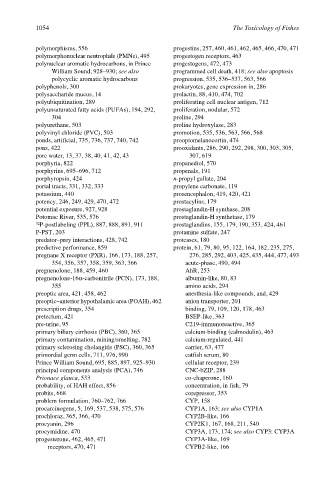Page 1074 - The Toxicology of Fishes
P. 1074
1054 The Toxicology of Fishes
polymorphisms, 556 progestins, 257, 460, 461, 462, 465, 466, 470, 471
polymorphonuclear neutrophils (PMNs), 495 progestogen receptors, 463
polynuclear aromatic hydrocarbons, in Prince progestogens, 472, 473
William Sound, 928–930; see also programmed cell death, 418; see also apoptosis
polycyclic aromatic hydrocarbons progression, 535, 536–537, 563, 566
polyphenols, 300 prokaryotes, gene expression in, 286
polysaccharide mucus, 14 prolactin, 88, 410, 474, 702
polyubiquitination, 289 proliferating cell nuclear antigen, 712
polyunsaturated fatty acids (PUFAs), 194, 292, proliferation, nodular, 572
304 proline, 294
polyurethane, 503 proline hydroxylase, 283
polyvinyl chloride (PVC), 503 promotion, 535, 536, 563, 566, 568
ponds, artificial, 735, 736, 737, 740, 742 proopiomelanocortin, 474
pons, 422 prooxidants, 286, 290, 292, 298, 300, 303, 305,
pore water, 13, 37, 38, 40, 41, 42, 43 307, 619
porphyria, 822 propanediol, 570
porphyrins, 695–696, 712 propenals, 191
porphyropsin, 424 n-propyl gallate, 204
portal tracts, 331, 332, 333 propylene carbonate, 119
potassium, 440 prosencephalon, 419, 420, 421
potency, 246, 249, 429, 470, 472 prostacylins, 179
potential exposure, 927, 928 prostaglandin-H synthase, 208
Potomac River, 535, 576 prostaglandin-H synthetase, 179
32 P-postlabeling (PPL), 887, 888, 891, 911 prostaglandins, 155, 179, 190, 353, 424, 461
P-PST, 203 protamine sulfate, 247
predator–prey interactions, 428, 742 proteases, 180
predictive performance, 859 protein, 61, 79, 80, 95, 122, 164, 182, 235, 275,
pregnane X receptor (PXR), 166, 173, 188, 257, 276, 285, 292, 403, 425, 435, 444, 477, 493
354, 356, 357, 358, 359, 363, 366 acute-phase, 490, 494
pregnenolone, 188, 459, 460 AhR, 253
pregnenolone-16α-carbonitrile (PCN), 173, 188, albumin-like, 80, 83
355 amino acids, 294
preoptic area, 421, 458, 462 anesthesia-like compounds, and, 429
preoptic–anterior hypothalamic area (POAH), 462 anion transporter, 201
prescription drugs, 354 binding, 79, 109, 120, 178, 463
pretectum, 421 BSEP-like, 363
pre-urine, 95 C219-immunoreactive, 365
primary biliary cirrhosis (PBC), 360, 365 calcium-binding (calmodulin), 463
primary contamination, mining/smelting, 782 calcium-regulated, 441
primary sclerosing cholangitis (PSC), 360, 365 carrier, 63, 477
primordial germ cells, 711, 976, 990 catfish serum, 80
Prince William Sound, 695, 885, 897, 925–930 cellular receptor, 239
principal components analysis (PCA), 746 CNC-bZIP, 288
Prionace glauca, 533 co-chaperone, 160
probability, of HAH effect, 856 concentration, in fish, 79
probits, 668 corepressor, 353
problem formulation, 760–762, 766 CYP, 158
procarcinogens, 5, 169, 537, 538, 575, 576 CYP1A, 163; see also CYP1A
prochloraz, 365, 366, 470 CYP2B-like, 166
procyanin, 296 CYP2K1, 167, 168, 211, 540
procymidine, 470 CYP3A, 173, 174; see also CYP3: CYP3A
progesterone, 462, 465, 471 CYP3A-like, 169
receptors, 470, 471 CYPB2-like, 166

